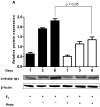Hops (Humulus lupulus) inhibits oxidative estrogen metabolism and estrogen-induced malignant transformation in human mammary epithelial cells (MCF-10A)
- PMID: 21997247
- PMCID: PMC3252489
- DOI: 10.1158/1940-6207.CAPR-11-0348
Hops (Humulus lupulus) inhibits oxidative estrogen metabolism and estrogen-induced malignant transformation in human mammary epithelial cells (MCF-10A)
Abstract
Long-term exposure to estrogens including those in traditional hormone replacement therapy (HRT) increases the risk of developing hormone-dependent cancers. As a result, women are turning to over-the-counter (OTC) botanical dietary supplements, such as black cohosh (Cimicifuga racemosa) and hops (Humulus lupulus), as natural alternatives to HRT. The two major mechanisms which likely contribute to estrogen and/or HRT cancer risk are: the estrogen receptor-mediated hormonal pathway; and the chemical carcinogenesis pathway involving formation of estrogen quinones that damage DNA and proteins, hence initiating and promoting carcinogenesis. Because, OTC botanical HRT alternatives are in widespread use, they may have the potential for chemopreventive effects on estrogen carcinogenic pathways in vivo. Therefore, the effect of OTC botanicals on estrogen-induced malignant transformation of MCF-10A cells was studied. Cytochrome P450 catalyzed hydroxylation of estradiol at the 4-position leads to an o-quinone believed to act as the proximal carcinogen. Liquid chromatography/tandem mass spectrometry analysis of estradiol metabolites showed that 4-hydroxylation was inhibited by hops, whereas black cohosh was without effect. Estrogen-induced expression of CYP450 1B1 and CYP450 1A1 was attenuated by the hops extract. Two phenolic constituents of hops (xanthohumol, XH; 8-prenylnaringenin, 8-PN) were tested: 8-PN was a potent inhibitor, whereas XH had no effect. Finally, estrogen-induced malignant transformation of MCF-10A cells was observed to be significantly inhibited by hops (5 μg/mL) and 8-PN (50 nmol/L). These data suggest that hops extracts possess cancer chemopreventive activity through attenuation of estrogen metabolism mediated by 8-PN.
©2011 AACR.
Figures








Similar articles
-
Evaluation of estrogenic activity of licorice species in comparison with hops used in botanicals for menopausal symptoms.PLoS One. 2013 Jul 12;8(7):e67947. doi: 10.1371/journal.pone.0067947. Print 2013. PLoS One. 2013. PMID: 23874474 Free PMC article.
-
Hop (Humulus lupulus L.) Extract and 6-Prenylnaringenin Induce P450 1A1 Catalyzed Estrogen 2-Hydroxylation.Chem Res Toxicol. 2016 Jul 18;29(7):1142-50. doi: 10.1021/acs.chemrestox.6b00112. Epub 2016 Jun 22. Chem Res Toxicol. 2016. PMID: 27269377 Free PMC article.
-
The Multiple Biological Targets of Hops and Bioactive Compounds.Chem Res Toxicol. 2019 Feb 18;32(2):222-233. doi: 10.1021/acs.chemrestox.8b00345. Epub 2019 Jan 22. Chem Res Toxicol. 2019. PMID: 30608650 Free PMC article. Review.
-
In vivo estrogenic comparisons of Trifolium pratense (red clover) Humulus lupulus (hops), and the pure compounds isoxanthohumol and 8-prenylnaringenin.Chem Biol Interact. 2008 Oct 22;176(1):30-9. doi: 10.1016/j.cbi.2008.06.005. Epub 2008 Jun 20. Chem Biol Interact. 2008. PMID: 18619951 Free PMC article.
-
Mechanisms of estrogen carcinogenesis: The role of E2/E1-quinone metabolites suggests new approaches to preventive intervention--A review.Steroids. 2015 Jul;99(Pt A):56-60. doi: 10.1016/j.steroids.2014.08.006. Epub 2014 Aug 24. Steroids. 2015. PMID: 25159108 Free PMC article. Review.
Cited by
-
Role of dietary bioactive natural products in estrogen receptor-positive breast cancer.Semin Cancer Biol. 2016 Oct;40-41:170-191. doi: 10.1016/j.semcancer.2016.03.001. Epub 2016 Mar 22. Semin Cancer Biol. 2016. PMID: 27016037 Free PMC article. Review.
-
Evaluation of estrogenic activity of licorice species in comparison with hops used in botanicals for menopausal symptoms.PLoS One. 2013 Jul 12;8(7):e67947. doi: 10.1371/journal.pone.0067947. Print 2013. PLoS One. 2013. PMID: 23874474 Free PMC article.
-
Perfluorooctanoic acid (PFOA) exposure promotes proliferation, migration and invasion potential in human breast epithelial cells.Arch Toxicol. 2018 May;92(5):1729-1739. doi: 10.1007/s00204-018-2181-4. Epub 2018 Mar 3. Arch Toxicol. 2018. PMID: 29502166 Free PMC article.
-
Induction of NAD(P)H:Quinone Oxidoreductase 1 (NQO1) by Glycyrrhiza Species Used for Women's Health: Differential Effects of the Michael Acceptors Isoliquiritigenin and Licochalcone A.Chem Res Toxicol. 2015 Nov 16;28(11):2130-41. doi: 10.1021/acs.chemrestox.5b00310. Epub 2015 Nov 5. Chem Res Toxicol. 2015. PMID: 26473469 Free PMC article.
-
Botanicals and Their Bioactive Phytochemicals for Women's Health.Pharmacol Rev. 2016 Oct;68(4):1026-1073. doi: 10.1124/pr.115.010843. Pharmacol Rev. 2016. PMID: 27677719 Free PMC article. Review.
References
-
- Russo J, Hasan Lareef M, Balogh G, Guo S, Russo IH. Estrogen and its metabolites are carcinogenic agents in human breast epithelial cells. J Steroid Biochem Mol Biol. 2003;87:1–25. - PubMed
-
- Bolton JL. Mechanisms of Estrogen Carcinogenesis: Modulation by Botanical Natural Products. In: Penning TM, editor. Chemical Carcinogenesis. Humana Press; 2011. pp. 75–93.
Publication types
MeSH terms
Substances
Grants and funding
LinkOut - more resources
Full Text Sources
Other Literature Sources
Medical
Research Materials

